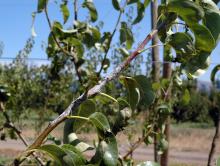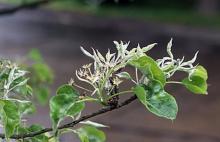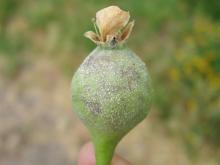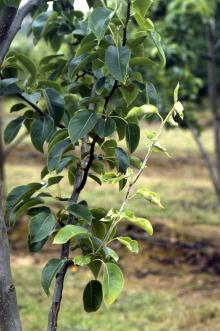See:
Apple (Malus spp.) - Powdery Mildew
Cause Podosphaera leucotricha, a fungus that overwinters in terminal buds of apples. Other host plants include crabapple, and quince. Pear orchards are at a higher risk of disease development if planted next to apple orchards. The disease is important on the cultivar d'Anjou where a smooth fruit finish is highly desired. Leaf and terminal infection seldom cause economic losses except in the nursery. 'Bartlett' rarely has a problem with this disease.
Infected terminal buds of apple and sometimes pear develop into shoots covered with conidia. Spore dispersal is favored by wind and warm temperatures but inhibited by leaf wetness.
Symptoms On pear fruit, white mycelium is visible until early June when it sloughs off, leaving a russeted patch where cells died. The russeted area expands as the fruit enlarge. Infected terminal buds have an open pointed appearance.
Cultural control
- Plant resistant cultivars.
- Locate orchards upwind and/or at a distance from apple orchards.
- Remove infected terminal buds from pear trees and especially from adjacent apple blocks.
Chemical control Apply fungicides from 3 weeks before to 4 weeks after bloom because pear fruit is susceptible to russeting in this period. 'Bartlett' rarely has a problem with the disease and so does not need to be sprayed. Alternate or tank-mix products from different groups that have different modes of action. Limit the use of any one group during crop production. Selection of products for rotation and/or mixing must consider group 7 fungicides when used through the irrigation as a nematicide.
- Aprovia at 5.5 to 7 fl oz/A plus an adjuvant. Do not use within 30 days of harvest. Group 7 fungicide. 12-hr reentry.
- Axios 20 SC at 2.25 to 3 fl oz/A. Do not use within 7 days of harvest. Group 52 fungicide. 4-hr reentry.
- Bicarbonate-based products. Might supplement a normal program when powdery mildew is first observed. Do not mix with acidifying agents. Thorough coverage is essential. Poor to moderate control. O
- Kaligreen (82% potassium bicarbonate) at 2.5 to 3 lb/A. 4-hr reentry.
- MilStop (85% potassium bicarbonate) at 2.5 to 5 lb/A. Oregon and Washington only. 1-hr reentry.
- Monterey Bi-Carb Old Fashioned Fungicide at 4 teaspoons/2 gal water. H
- Cevya at 5 fl oz/A. Can be used on day of harvest. Group 3 fungicide. 12-hr reentry.
- Cinnerate at 16 to 64 fl oz/100 gal water plus an adjuvant. 4-hr reentry. O
- EcoSwing at 1.5 to 2 pints/A. Can be used day of harvest. Group BM01 fungicide. 4-hr reentry. O
- Flint Extra at 2.5 to 2.9 fl oz/A. Do not within 14 days of harvest. Injury may occur to Concord grapes if accidentally sprayed. Group 11 fungicide. 12-hr reentry.
- Fontelis at 16 to 20 fl oz/A. Do not use within 28 days of harvest. Group 7 fungicide. 12-hr reentry.
- Horticultural Mineral Oils (HMO). Generally effective from 1% to 2% volume to volume. Necrotic foliage may result if applied within 10 days of any sulfur application. Do not tank-mix with copper-based products when fruit is present. Do not use during freezing temperatures, above 90°F, or when plants are under heat or moisture stress. Do not use when foliage is wet because good coverage is essential. 4-hr reentry. O
- JMS Stylet Oil at 1 to 2 gal/100 gal water.
- SuffOil-X at 1 to 2 gal/100 gal water.
- Inspire Super at 12 fl oz/A. Do not apply within 14 days of harvest. Group 3 + 9 fungicide. 12-hr reentry.
- Luna Sensation at 5 to 5.8 fl oz/A. Do not use with HMOs or within 14 day of harvest. Group 7 + 11 fungicide. 12-hr reentry.
- Luna Tranquility at 11.2 to 16 fl oz/A. Do not use within 72 days of harvest. Group 7 + 9 fungicide. 12-hr reentry.
- Merivon at 4 to 5.5 fl oz/A. Do not use with EC or oil-based products. May be used day of harvest. Group 7 and 11 fungicide. 12-hr reentry.
- Miravis at 3.4 fl oz/A. Do not use within 30 days of harvest. Group 7 fungicide. 12-hr reentry.
- Oso SC at 6.5 to 13 fl oz/A. May be applied on the day of harvest. Group 19 fungicide. 4-hr reentry. O
- Ph-D WDG at 6.2 oz/A. May be applied on the day of harvest. Group 19 fungicide. 4-hr reentry.
- Pristine at 14.5 to 18.5 oz/A. Can be used day of harvest. Do not use with an HMO. Group 7 + 11 fungicide. 12-hr reentry.
- Problad Verde at 18.1 to 45.7 fl oz/A. Needs 8 to 12 hours dry time to absorb into treated tissue. Do not use within one day of harvest. Group BM01 fungicide. 4-hr reentry.
- Procure 480 SC at 8 to 16 fl oz/A. Do not apply within 14 days of harvest. Group 3 fungicide. 12-hr reentry.
- Regalia at 1 to 4 quarts/A. Use on 7-day intervals. May be used day of harvest. Does not benefit from the addition of an adjuvant. Group P5 fungicide. 4-hr reentry. O
- Rex Lime Sulfur Solution (28%) at 0.5 to 2 gal/100 gal water depending on growth stage. Do not use on 'd'Anjou', 'Comice', or 'Seckle', or with oil. 48-hr reentry. O
- Rhyme at 4 to 6 fl oz/A. Can be used through a drip or microsprinkler system at higher rate. Do not use within 14 days of harvest. Group 3 fungicide. 12-hr reentry.
- Sil-Matrix at 1 to 4 quarts/100 gal water plus a nonionic surfactant. Can be applied up to the day of harvest. 4-hr reentry. O
- Sovran at 4 to 6.4 oz/A. Rotate with other fungicides that have different modes of action. Do not apply within 30 days of harvest. Some sweet cherries, such as 'Van', may be injured if accidentally sprayed. Group 11 fungicide. 12-hr reentry.
- Sulfur-based products. Do not apply at temperatures above 80°F because sulfurs can russet fruit. Do not apply near an oil spray or apply to 'Anjou' pear. Group M2 fungicides. 24-hr reentry. O
- Microthiol Disperss (80% sulfur) at 10 to 20 lb/A. Do not use a spreader-sticker.
- Safer Brand Garden Fungicide (12% sulfur) at 2 fl oz/gal water thoroughly sprayed over the entire plant. H
- Tebucon 45 DF at 4 to 8 oz/A. It is unknown if there is a PGR effect on shape when using these products during bloom. Do not use within 75 days of harvest. Group 3 fungicides. 5-day reentry.
- Tesaris at 3.5 to 4.5 fl oz/A. Do not use with oil-based products. May be used day of harvest. Group 7 fungicide. 12-hr reentry.
- Topguard SC at 8 to 12 fl oz/A. Do not use within 14 days of harvest. Group 3 fungicide. 12-hr reentry.
- Topsin M WSB at 1 lb/A plus another fungicide. Do not use within 1 day of harvest. Do not use at any time in the orchard if your packing house uses a benzimidazole (such as Mertect or Decco Salt 19) postharvest. Group 1 fungicide. 2-day reentry.
- Torino at 6.8 oz/A. Do not use within 14 days of harvest. Group U6 fungicide. 4-hr reentry.
- Trionic 4 SC at 8 to 16 fl oz/A. Do not apply within 14 days of harvest. Group 3 fungicide. 12-hr reentry.
Chemical control only for flowering pear
- Eagle 20 EW at 6 to 12 fl oz/100 gal water. Group 3 fungicide. 24-hr reentry.
- Heritage at 1 to 4 oz/100 gal water plus a non-silicone-based wetter sticker. Group 11 fungicide. 4-hr reentry.
- Insignia SC at 3 to 6 fl oz/100 gal water. Do not use with organosilicate-based adjuvants. Group 11 fungicide. 12-hr reentry.
- Myclobutanil 20 EW T&O at 6 to 12 fl oz/100 gal water plus spreading agent. May observe a PGR effect. Group 3 fungicide. 24-hr reentry.
- Pageant at 6 to 12 oz/100 gal water. Do not use with organosilicone-based adjuvants. Group 7 + 11 fungicide. 12-hr reentry.
- Spectracide Immunox Multi-Purpose Fungicide Spray Concentrate for Gardens at 1 fl oz/gal water. Group 3 fungicide. H
Biological control
- Aviv (Bacillus subtilis strain IAB/BS03) at 10 to 30 fl oz/100 gal water. Unknown efficacy. Preharvest interval not specified. 4-hr reentry. O
- Double Nickel 55 (Bacillus amyloliquefaciens strain D747) at 0.25 to 3 lb/A. Unknown efficacy. Group BM02 fungicide. 4-hr reentry. O
- Serenade OPTI (Bacillus subtilis strain QST 713) at 14 to 20 oz /A. Active ingredient is a small protein. Effectiveness as a commercial treatment is unknown in the Pacific Northwest. 4-hr reentry. O
- Serenade Garden Disease Control Concentrate at 2 to 4 fl oz/gal water. Effectiveness as a commercial treatment is unknown in the Pacific Northwest. H O
- Sonata (Bacillus pumilis strain QST 2808) at 2 to 4 quarts/A plus an adjuvant. May be applied up to and including the day of harvest. 4-hr reentry. O
- Theia (Bacillus subtilis strain AFS032321) at 1.5 to 5 lb/A. May be applied up to and including the day of harvest. 4-hr reentry. O
Reference Spotts, R.A. 1984. Infection of Anjou pear fruit by Podosphaera leucotricha. Plant Disease 68:857-859.





